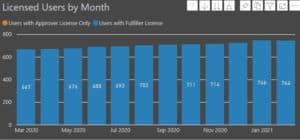The price of a rational ServiceNow renewal bill is eternal vigilance – Attribution Unknown
Way back in the normal times, after lunching with colleagues indoors, we would return to our software license audits and find unused licenses that accounted for 5-10% of the total. We would assign tasks to the departments with idle licenses and tell ourselves that we would need to keep an eye on that.
I don’t know about you, but last year was somewhat unusual for us. The slow shifting of personnel that regularly orphans software licenses accelerated until departments became unrecognizable. The software audits that we perform for our customers started turning up unused licenses in the 20-30% range. What had been a duty of diligence, like changing the air filters, or mailing back the DVD has become a top-of-the-agenda action item. Let’s focus on ServiceNow as a representative case, but the example will serve many.
ServiceNow Renewal – Understand your Hand
A software license based on the number of users has a built-in advantage for a SaaS software provider. In most cases, they know, or at least can pretend to know the usage of the software better than you. It can feel like you’re playing poker with someone that can see your cards.
Knowing your hand and theirs is always the most important factor in a successful ServiceNow renewal negotiation. It is guaranteed that they are coming with new licensing structures, new product offerings, and plans for expansions in the license base. Once these are accepted in one renewal, they can become very difficult to unwind in subsequent negotiations. ServiceNow is not going to make it easy for you to see where you can push back and slow down the growth of the overall bill.
ServiceNow is going to have a detailed list of users that they can back up with data. The spreadsheets are long. The user’s names are obscured, but the detail seems to be consistent. It makes some intuitive sense that the number of licenses required is going to increase by a low double-digit percentage. Without the detail to push back, most of us just bend our knees and move on to the next point.
Preparation and a structured audit can help here. Visibility into the people, departments, and roles is going to uncover unused licenses in three areas:
- License Churn
- Zombie Licenses
- Over-permission
By identifying a pool of unused license capacity, you can typically cut out the line item for additional licenses completely. In many cases, this is large enough to push for savings and credits in other areas.
License Churn
It happens to the best of us. In a normal year, there is always a non-negligible amount of churn in the employee base that inflates the number of licenses “consumed.” For example, if David Lee moves on and is replaced by Sammy, both may appear to be valid users of the system and get double counted in the user base. When there is a significant change to the organization, like offshoring or perhaps the complete virtualization of the workforce for a year due to an unforeseen global pandemic, the impact on license utilization can be enormous. Again, 20-30% is not unusual emerging from the debris of 2020.
Zombie Licenses
Zombie licenses are a special form of churn. We typically consider churn to licenses that have gone inactive from one renewal to the next. Zombies have either survived from a previous renewal, or they have never been used. They differ from churn in that their number doesn’t spike in current events, but when running an audit for a new customer, we typically see around 10% of the licenses unused for over a year. This level alone can be enough to freeze the license growth in a renewal negotiation.
Over-Permission
The third area of savings is over-permission licenses. The most concrete and typical case is the proliferation of ITIL licenses. As ServiceNow reaches farther into the organization, the understanding of roles becomes even more critical. ServiceNow has powerful functionality around Agile and project management. However, these functions do not require the more expensive ITIL licenses.
There are different flavors of this, but the most common is a type of ITIL zombie, where the user is active in ServiceNow, but has never performed an ITIL task. There is also ITIL churn, where the user remains active but no longer performs tasks requiring the ITIL role.
Know More than your Opponent
ServiceNow roles are added and revoked to users every day. Each one has the potential to drive license costs but is very difficult to monitor without individual records in history. A role that is added on the last day of the year should not cost the same as one that was added on January 1. ServiceNow will view them the same way in renewal because they do not have that level of visibility. When making your projections for license use, the proper metrics are role utilization days. Projections made from this basis will always be lower than those viewed from the full year, and more accurately track your organization’s full utilization.

Be Prepared
Make sure you walk into your renewal negotiation with your own targets for next year’s licenses. If you have clearly identified these areas of savings and can tie specific user names to the areas, you will at least be able to freeze this area of growth in your overall license cost. At best, you will be able to further rationalize your bill and bring your cost in line with actual usage. If you need help in preparing this detail, Northcraft Analytics can provide you with a detailed suite of interactive reports for use in your next negotiation. Just click the illustrative graphic below to contact us.
